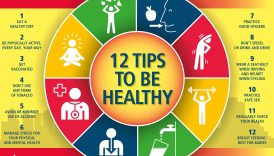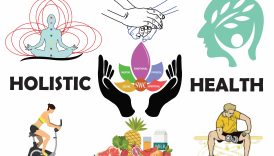Embarking on a Healthy Living Journey: A Beginner’s Guide
Understanding the Basics of Healthy Living
What is Healthy Living?
Healthy living encompasses a holistic approach to well-being that integrates physical, mental, and emotional health. It’s not just about avoiding illness; it’s about thriving in all aspects of life. For many, healthy living means making conscious choices that enhance overall quality of life. This can include eating a balanced diet, engaging in regular physical activity, and prioritizing mental health. Individuals might find their own unique paths to healthy living, but key components generally include:
- Embarking on a Healthy Living Journey: A Beginner’s Guide
- Understanding the Basics of Healthy Living
- What is Healthy Living?
- Benefits of Adopting a Healthy Lifestyle
- Setting Goals for Your Health Journey
- Short-term vs. Long-term Goals
- Creating a Realistic Action Plan
- Nutrition and Hydration Tips for Beginners
- Balancing Macronutrients
- Importance of Hydration
- Incorporating Physical Activity into Your Routine
- Choosing the Right Exercise for You
- Overcoming Barriers to Fitness
- Prioritizing Mental Health and Self-Care
- Stress Management Techniques
- Importance of Rest and Recovery
- Balanced Diet: Emphasizing whole foods, such as fruits, vegetables, whole grains, and lean proteins.
- Physical Activity: Finding an exercise routine that fits personal preferences and lifestyle—be it yoga, running, or simply taking regular walks.
- Mental Well-Being: Techniques like mindfulness, meditation, or therapeutic practices to foster emotional resilience.
Take Sarah, for example, who struggled with her health for years. By adopting these principles, she found herself feeling more energized, focused, and fulfilled.
Benefits of Adopting a Healthy Lifestyle
The benefits of living a healthy lifestyle are plentiful and often interlinked. Not only does it promote physical well-being, but it also enhances mental and emotional health. Some key advantages include:
- Increased Energy Levels: A balanced diet and regular exercise boost overall energy, allowing individuals to tackle daily tasks more efficiently.
- Better Mood Regulation: Physical activity releases endorphins, which can help alleviate stress and improve mood.
- Enhanced Longevity: Healthy choices can lead to a longer, more vibrant life, reducing the risk of chronic diseases.
- Improved Cognitive Function: A nutritious diet and active lifestyle are essential for brain health, leading to better memory and focus.
Incorporating healthy habits can create a ripple effect, inspiring friends and family to consider their health choices, fostering a community of well-being. Whether it’s joining a local fitness class or sharing nutritious recipes, the journey toward healthy living can be a shared and rewarding experience.
Setting Goals for Your Health Journey
Short-term vs. Long-term Goals
Once individuals grasp the basics of healthy living, the next step is to set achievable goals that propel them on their health journey. It’s essential to distinguish between short-term and long-term goals, as both serve different purposes but play vital roles in achieving overall health. Short-term goals are typically achievable within a few weeks or months. They provide quick wins and boost motivation. For example:
- Incorporate one serving of vegetables into every meal.
- Commit to walking 10 minutes daily.
- Drink an extra glass of water daily.
These small yet impactful steps can quickly enhance daily habits and build confidence. In contrast, long-term goals extend over several months or years, requiring sustained effort and commitment. They usually aim for significant lifestyle changes. Examples might include:
- Losing 20 pounds in six months.
- Completing a half-marathon by next year.
- Preparing all meals at home for one month.
Establishing both types of goals creates a balanced approach to health improvement, making it easier to celebrate progress along the way.
Creating a Realistic Action Plan
Setting goals is just the beginning; creating a realistic action plan is crucial for ensuring success. A well-structured plan helps to keep individuals focused and accountable. Here’s how to construct a practical and actionable plan:
- Identify Specific Goals: Clearly outline what you want to achieve, ensuring each goal is measurable. For instance, instead of saying “I want to be fit,” specify “I will work out three times a week for 30 minutes.”
- Break Down Goals: Divide large goals into smaller steps. Breaking a long-term goal into manageable tasks can make it seem less overwhelming. For example, if the goal is to lose 20 pounds, aim to shed 1-2 pounds weekly.
- Set a Timeline: Establish deadlines for each goal, helping to maintain momentum and commitment.
- Track Progress: Keep a journal or app to document achievements and setbacks, allowing for adjustments when needed.
- Seek Support: Engage friends or family members, or consider joining support groups to share experiences and foster accountability.
Creating a realistic action plan enables individuals to stay committed to their health journeys, making the process rewarding and enjoyable. By setting clear goals and actionable steps, anyone can transform their aspirations into achievable realities.
Nutrition and Hydration Tips for Beginners
Balancing Macronutrients
As individuals embark on their health journeys, understanding nutrition plays a pivotal role. One key aspect is balancing macronutrients—proteins, carbohydrates, and fats. Each macronutrient serves a distinct purpose, and having the right proportions can significantly impact energy levels, wellness, and overall health.
- Proteins: Essential for muscle repair and growth. Incorporating lean sources such as chicken, fish, beans, and legumes can help meet daily protein needs. Aiming for about 20-30% of daily caloric intake from proteins is a great start.
- Carbohydrates: The body’s primary energy source. Opt for complex carbohydrates—think whole grains, fruits, and vegetables—that provide sustained energy. These should make up approximately 45-65% of your daily intake.
- Fats: Often misunderstood, healthy fats are crucial for hormone production and nutrient absorption. Sources like avocados, nuts, and olive oil are ideal. They should constitute around 20-35% of total daily calories.
When Sarah first began her health journey, she struggled to find the right balance. By using a simple plate method—filling half her plate with vegetables, a quarter with lean protein, and a quarter with whole grains—she found it easier to visualize her meals and ensure proper macronutrient distribution.
Importance of Hydration
Equally important to nutrition is hydration. Water plays a vital role in nearly every bodily function. Staying hydrated improves concentration, digestion, and energy levels, making it a cornerstone of healthy living. Here are some straightforward tips for maintaining optimal hydration:
- Set a Daily Goal: Aim for at least 8-10 cups (about 2-2.5 liters) of water a day. Individual needs may vary, so adjusting based on activity level and climate is wise.
- Infuse Water with Flavor: If plain water isn’t appealing, try adding slices of lemon, cucumber, or berries to enhance flavor without added sugars.
- Track Intake: Utilize apps or simple water tracking bottles to keep an eye on your daily intake. Visual reminders make it easier to remember to drink throughout the day.
- Stay Hydrated During Meals: Drinking a glass of water before meals can aid in digestion and help control portion sizes.
- Hydrate While Exercising: Ensure hydration is a part of any fitness routine, particularly during longer or intense workouts.
Balancing macronutrients and prioritizing hydration can transform one’s approach to healthy living. By implementing these foundational practices, individuals can set themselves up for ongoing success in their health journeys.
Incorporating Physical Activity into Your Routine
Choosing the Right Exercise for You
With nutrition and hydration firmly in place, the next essential aspect of a healthy lifestyle is incorporating physical activity. However, choosing the right exercise can sometimes be overwhelming, especially with the plethora of options available. It’s vital to select activities that not only align with personal goals but also bring enjoyment, ensuring consistency in practice. Start by considering different types of exercises:
- Cardiovascular (Aerobic) Exercises: These include running, cycling, swimming, and dancing. They are fantastic for heart health and increasing stamina.
- Strength Training: Activities like weightlifting, resistance band workouts, or body-weight exercises (think push-ups and squats) build muscle and enhance metabolism.
- Flexibility and Balance: Yoga and Pilates improve flexibility while promoting mindfulness, making them excellent for mental health as well.
- Recreational Activities: Sports, hiking, or even group classes can make exercising feel more like fun rather than a chore.
Take Mark, for instance—initially hesitant about exercising, he discovered a joy for dance classes. Finding an activity he loved not only kept him active but also transformed his social life.
Overcoming Barriers to Fitness
Often, individuals encounter barriers that impede their ability to maintain regular exercise. Identifying and addressing these obstacles is crucial for long-term success. Here are some common barriers and practical solutions:
- Time Constraints: Busy schedules can make it hard to fit in workouts. Consider breaking workouts into shorter sessions, or utilize active commuting strategies like biking or walking when possible.
- Lack of Motivation: A workout buddy or joining a group class can bring camaraderie and accountability. Sharing fitness goals with friends can boost motivation.
- Intimidation at the Gym: For beginners, gyms may feel overwhelming. Start with home workouts or seek smaller, community classes that foster a more inclusive environment.
- Injury Concerns: Consult a healthcare provider or a fitness expert to adapt exercises that accommodate any existing injuries, ensuring safety while staying active.
By proactively addressing these barriers, individuals can find their own paths to integrating physical activity into their daily lives. Establishing a routine with enjoyable and accessible exercises empowers everyone to embody a healthier, more active lifestyle. Adopting these practices not only paves the way for physical health but also nurtures mental resilience, leading to a fulfilling health journey.
Prioritizing Mental Health and Self-Care
Stress Management Techniques
As individuals diligently foster their physical health, it is equally important to prioritize mental health and self-care. Effectively managing stress is a key component of maintaining overall well-being. Life can often feel overwhelming, making it essential to employ stress management techniques that promote balance. Here are some effective stress management strategies:
- Mindfulness and Meditation: Engaging in mindfulness practices or meditation can help ground individuals in the present moment. Just a few minutes of focused breathing or guided meditation can significantly reduce stress levels.
- Physical Activity: As previously discussed, exercise isn’t just great for physical health; it also releases endorphins, the body’s natural mood lifters. Activities like brisk walking, yoga, or dance can provide a natural outlet for stress relief.
- Journaling: Writing down thoughts and feelings can help individuals process emotions and gain perspective on stressful situations. Setting aside a few minutes daily to journal can serve as a mental detox.
- Connect with Others: Talking to friends, family, or mental health professionals can provide valuable support. Sharing feelings and experiences fosters deeper connections and alleviates feelings of isolation.
Take Linda, who found herself increasingly stressed by work demands. By incorporating simple mindfulness techniques and keeping a weekly journal, she managed to regain clarity and calm, significantly improving her mental outlook.
Importance of Rest and Recovery
Rest and recovery are equally crucial in the pursuit of mental wellness. Often underestimated, adequate rest allows the mind and body to rejuvenate, ensuring sustained performance during daily activities. Here are some key considerations regarding rest and recovery:
- Adequate Sleep: Aim for 7-9 hours of sleep per night. Sleep impacts mood, cognitive function, and immune system health. Prioritizing a consistent sleep schedule can facilitate better rest.
- Scheduled Downtime: Just as one schedules workouts, setting aside time for relaxation and leisure activities is vital. Whether it’s reading, taking a warm bath, or enjoying a hobby, these moments recharge emotional batteries.
- Taking Breaks: During busy days, short breaks can enhance productivity and mitigate stress. Incorporate brief moments of stretching or stepping outside to clear the mind.
- Digital Detox: Regularly stepping away from screens and social media can significantly reduce cognitive overload. Designate times in the day to unplug and focus on offline activities.
By integrating stress management techniques and prioritizing rest, individuals can cultivate a healthier mental state that complements their physical efforts. Recognizing the importance of mental health in overall wellness ensures a comprehensive approach to living a full and balanced life.





